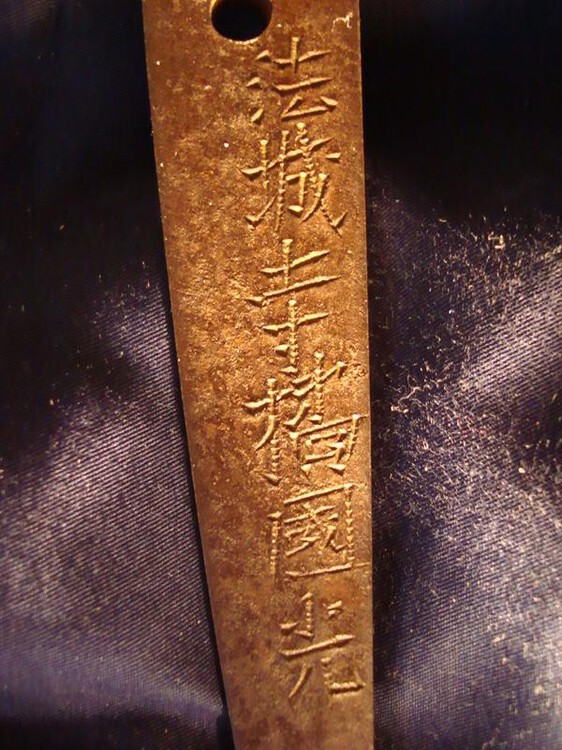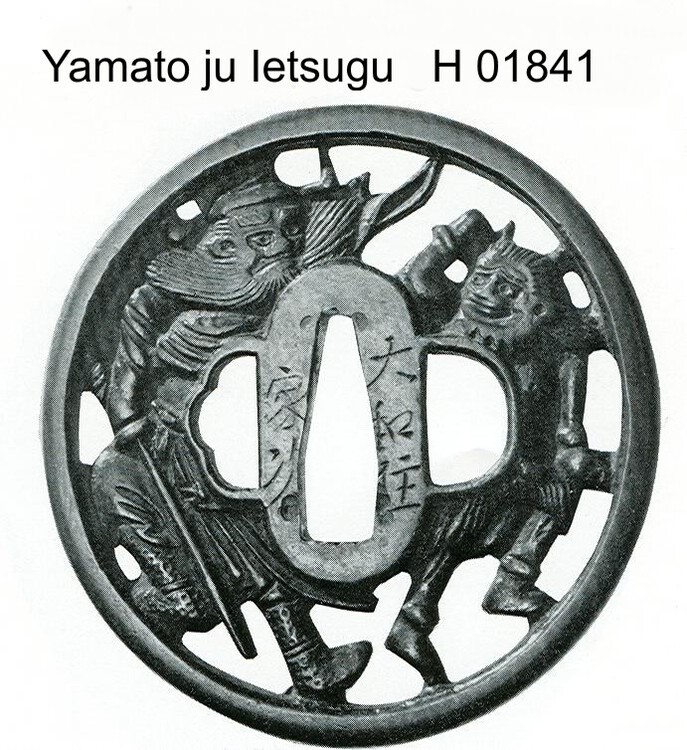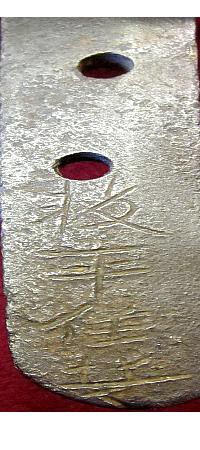
Ludolf Richter
Members-
Posts
491 -
Joined
-
Last visited
Content Type
Profiles
Forums
Events
Store
Downloads
Gallery
Everything posted by Ludolf Richter
-
Fuchi and gold translation help extra photos added?
Ludolf Richter replied to LONGHURST's topic in Translation Assistance
Iwama Masayoshi (Haynes H 04907) was working till his death in 1837:I have pics in my Tosogu-Database with Mei plus age "63" till "72".He was a disciple of 3 Hamano artists (married to the daughter of one of them) till he became independant.I couldn't find names of possible students:maybe he had none?!He is said to have imitated the style of other prominent Tosogu artists.Ludolf -
May I get a translation please if you would be so kind.
Ludolf Richter replied to max's topic in Translation Assistance
Let me try to answer some of your questions. As already stated by Jaques,Tachibana is a clan name like Fujiwara.According to Wikipedia (I had no idea till I just looked at Wikipedia!) the Tachibana-Clan was once one of the 4 most powerful families ("Kuge") at the Imperial Court.Later the Fujiwara-Clan became the No.1 (till the end of WW II !) and the Tachibana were not longer part of the Court.Their people spread all over Japan."Your" swordsmith claims to be a follower of that clan.Hojoji was a once famous school of swordsmiths.It is possible that the Hojoji-school ("Mon") was one with only followers of the Tachibana Clan,because there are some more swordsmiths that had added "Hojiji Tachibaba" (e.g.Echizen no Kami Masateru and Higo no Kami Masahiro-both 17th Century)to their name. The swordsmiths Go (art name)is Kunimitsu.There are Signatures by him with or without "Hojoji Tachibana". Hawley has listed about 20.000 swordsmiths,each with a reference number,yours with KUN (from Kuni) and 533 as the 533th entry in alphabetical sequence of the ones starting with "Kuni":KUN 533.Each entry contains some info:the Province where he worked,the date(s) or era,a figure for the relative value (in your case "35",i.e.above standard),and other data (e.g.what generation,if there were more than one or who was his teacher).The entry contains examples of his signatures ("Mei") ,if only the name (Go) or with addditional data like honory titles (e.g.Daijo or even Kami with the province-name where he had got that title ,e.g.Echigo no Kami),his origin province,e.g.Bizen Kuni (that Kuni means inhabitant/resident,preceded by "his" province name,either the full name or the abbrev.Chinese writing,e.g.Musashi or Bushu),clan names (Fujiwara,Minamoto,Tachibana),and (seldom) other data.The Hawley Index does not contain pictures of Mei!For that purpose when you want to check wether "you" signature is genuine or faked ("Gimei"),one has to use other-mostly Japanese-books.There are references with a Hawley entry,whether you can find pics in Watson's Koto-or-Shinto-books (with seperate English translations!) or the books by Tokuno or by Iida.Experts of our forum may have additional sources and should be willing to answer respective questions by members.In your case "KUN 533" has no reference to the above index-books.I couldn't find any Mei-pic in all my other books. The signaure may have the following endings:(Kanji for) saku-made this,tsukuru (same meaning),sei-made or kitau-forged,probably with an additional "kore" or "kin"/"kinzo".A few top swordsmith may have been granted the title if Imperial Swordsmith and start the signature with a chiselled chrysanthemum blossom,the mon of the Emperor. I hope,I could clarify most of your questions.Ludolf -
May I get a translation please if you would be so kind.
Ludolf Richter replied to max's topic in Translation Assistance
Hi,it's Hawley's KUN 533,Enpo Era,rated x35,working in Edo,Echizen,Tajima and a 4th province (Osshu in one of his Mei can mean any of 5 provinces).Watson has him on page 255 of the Shinto-Hen,but without pics,rated as chujosaku.There is not a single Mei-pic to be found in all mei books!I don't know,what Tachibana means,but Hojoji was an old school of swordsmiths,so he probably claims to be a descendant of that Mon.I have turned your pic.Ludolf -
Hi John,I don't understand:what do you mean?Ludolf
-
Hi Micko,it's Kuniteru,not the Shodai (KUN 1272,Shinto-Hen p.245),but it could be any of the other generations (2 to 7).There is not much to be found about these swordsmiths from Iyo Province.Nobody would have faked their Mei,so it's no Gimei.Ludolf
-
Tsuba looks like Jakushi , mei help .
Ludolf Richter replied to yogoro's topic in Translation Assistance
Hi!That's not a typical Tanaka-Tsuba.In addition there are not the big copper-inlays.The Kinko Jiten (Wakayama+Iida) has only one tsubako with that 1st Kanji:Koei (3 Kanji) from the Okamoto family,while Haynes has nil.It's uncommon to use uji/shi for family on a Tsuba.I don't know a single example for that.Normal was family/school-name preceding the Go.The 2nd Kanji of the Go can have the following meanings besides naga:hisa,take,tsune,masa and nobu.I do have a fine (typical) Tanaka-Tsuba,where the maker (Kazumichi) is not to be found in the books.When speaking of Kiyotoshi/Kiyonaga,the founder of the Tanaka-school,Joly wrote the following:"His best pupil was Toshikage (Nagakage),but I have found over thirty others,most of whose names are not recorded in Zanko Furiaku,published when the school was in its zenith." (Naunton Coll.p.168).Your artist may have been one of these 30 (like mine)!Ludolf -
Reference for Momoyama and Early Edo Period Tosho Tsuba...
Ludolf Richter replied to Soshin's topic in Tosogu
I believe,a Tsuba made by a swordsmith during the Momomoya-and -early-Shinto-period is a rare exception to those made by the new profession of Tsubako (Umetada,Kaneie,Nobuie,etc.).To date a Tosho-Tsuba to that late era is nearly unpossible.Ludolf -
I believe,it is neither Shodai (YAS 782,look at Fujishiro/Koto,Iida and Yoshu to Zuroku YTZ 1 p.22/23) nor Nidai (YAS 783,look at Token to Rekishi TTR 619,p.12 ),but Gimei.Those many chiselstrokes are not what a real known swordsmith would do!Ludolf
-
Help required with translation please
Ludolf Richter replied to ironron's topic in Translation Assistance
Hi Ron,I stopped bidding when the 200-limit had been reached.Ludolf -
Help required with translation please
Ludolf Richter replied to ironron's topic in Translation Assistance
Hi Ron,are you the buyer (GBP 226) ?Ludolf -
Help required with translation please
Ludolf Richter replied to ironron's topic in Translation Assistance
The seller has another (unsigned) Tsuba on Ebay,obviously made by the same artist.Look at the pic.Ludolf -
Help required with translation please
Ludolf Richter replied to ironron's topic in Translation Assistance
Hi Ron,I checked the Naokiyo Mei with all my index books and my private Tosogu-Database (more than 5000 pics):this Ebay-Naokiyo doesn't exist!There is only one Naokiyo in the books with these Kanji,a swordsmith from Choshu (Hawley NAO 63),who made some Tsuba besides his job as a swordsmith.From his Mei and the style it's not your guy.I believe,there is only one possibility,that he is a modern Tsubako,who may still be active.By the way,I couldn't find the meaning of the 1st Kanji on the right side in all my character dictionaries.I made an extract from the Ebay entry:look at the pic.Ludolf -
Watson,Nihonto Koza Vol.V.p.337.Ludolf
-
Hi John,here comes another example of the artist with a little bit different Mei (Shoshinmei!).Ludolf
-
Hi all,the results for swords are rising at German auctions.Here some of the December auction of Lempertz (Cologne): 1.I didn't get "my" Sumiyasu waki (look at my entry from nov22 "Need Help" in the translation-help-section),although the buyer din't probably know the real Mei (catalogue with "Makihira ju").It went away with Euro 1800 2.A Katana with Mei Kashu no Kami Kunisuke (for me an obvious Gimei!) was sold for Euro 3120 3.A Shinshinto Katana with Mei Kofu ju Minamoto Nobushige tsukure kore with date 1863 was sold for Euro 4080 4.An Aikuchi with Mei Sagami no Kuni Kamakura ju Tsunahiro with Horimono and a very rare high relief Koshirae (silver and shakudo,the Saya signed Masatsune).I didn't check the Mei of the catalogue pic,which generation of Tsunahiro it was. Result: unbelievable Euro 19.800 (ca.US $ 26.000)! Ludolf
-
Hi Keith,I did some research on Tsuneo: 1.He is in the "Tosogu-Bible" Kinko Jiten,an index book without pics,on page 704 as "Tsuneo" (family name Uchida,name Gonzaemon,born in Mito/Hitachi,working in the 2nd half of the 18th Century,son of Tsuneari,student of Yokoya Somin 2). 2.He is in Haynes with the reading Josei (H 02192) for the same Kanji!The infos are the same as above in the Kinko Jiten.With a different 2nd Kanji there is a second Josei (H 02193),who may be the same as H 02192. 3.Neither Tsuneo nor Josei are to be found in my other Japanese/English/German books.Only in the Naunton Collection there is a Kozuka from "Josei" without Kanji and a Mei pic. Ludolf
-
Hi Keith,this artist is one of a few in my database without reference to the Haynes index.Look at my pic.Ludolf
-
My thanks to Robert, Jacques, John and Grey!You got it. Now I hope to get the Wakizashi on the auction to come.Ludolf
-
Thank you experts for the "Naminohira"!There are a lot of swordsmiths from the Satsuma-Naminohira-School/Group in old Koto-times (Yasu--/Yuki--) with some big names like Yukiyasu.A few minor Shinto/Shinshinto-swordsmiths used that name too,although there was no longer a Naminohira-School.What is strange with this Mei is "ju",followed by a Kanji unlike Yasu or Yuki.The displayed upper part of the 4th Kanji could be from a "Fuji":Fujiwara.Till now I only found Mei with Naminohira,followed by the Go.I intend to look at all of them in the Nihonto Meikan and check your list,Grey.Ludolf
-
It is not distorted.Ludolf
-
Hi,I got a pic of a Wakizashi,which I am probably going to purchase.The problem is that the tang has been shortened obviously a long time ago,so the Go is not longer to be seen.The first 2 Kanji make no sense to me,the 2nd might be a ill chiselled "hira".The first one doesn't match with anyone,I have tried.My hope is that with your help this name might lead me to one or a grop of swordsmiths.Ludolf
-
To my German co-members:forget the "Schnaeppchen" (good/very good deal).The Katana at the Lempertz-Auction to come has a Gimei (I got an extra pic with the Mei from them).The faker didn't even try to chissel the Mei exactly like the ones from Shodai or Nidai (or Sandai or Yondai).Look at the pic ,where I have put together all the Kanji in 2 rows.I am very familiar with the first 2 gen.Kawachi no Kami Kunisuke,because that theme was part of our Conundrum some years ago.Ludolf
-
From my 7 Kikuchi-Tsunekatsu-pics is only one with shishi.Ludolf
-
-









